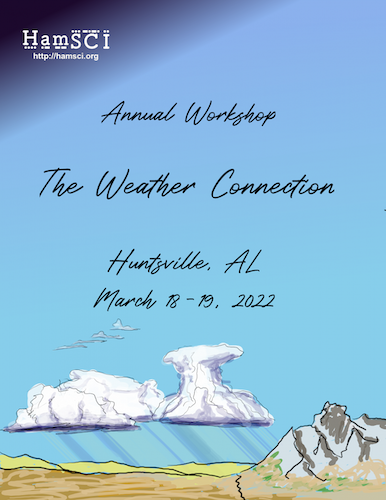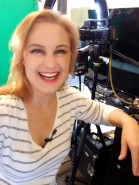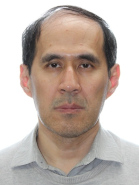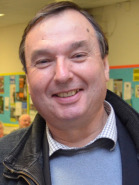
March 18-19, 2022
A Hybrid In-Person and Virtual Workshop
Come join HamSCI at its fifth annual workshop March 18-19, 2022 at the U.S. Space and Rocket Center in Huntsville, Alabama. The primary objective of the HamSCI workshop is to bring together the amateur radio community and professional scientists. The theme of the 2022 HamSCI Workshop is The Weather Connection.
This workshop will also serve as a team meeting for the HamSCI Personal Space Weather Station project, a NSF-funded project to develop a citizen science instrument for studying space weather from your backyard. The PSWS is led by the University of Scranton, and includes participation from TAPR, Case Western Reserve University/W8EDU, the University of Alabama, the New Jersey Institute of Technology CSTR, MIT Haystack Observatory, Dartmouth College, and the amateur radio community at large.
The 2022 HamSCI workshop is organized by The University of Scranton in collaboration with The University of Alabama and NASA Marshall Space Flight Center. Support is provided by the National Science Foundation.

Abstract: The paradigm shift that space weather is real, relevant and knowable to a general audience is not as impossible as once imagined. Although it remains a difficult topic to convey, new methods of teaching and communicating the hazards of the space environment to the technical non-expert and the public alike are far more accessible than in the past. In return, the appetite for more timely and accurate space weather information by these informed audiences is driving more robust observation and forecast methodologies. In this tutorial we will review how different kinds of space weather events impact the near-Earth space environment, driving different effects in the upper ionosphere. We will discuss several events and show how a heightened visibility of the space environment is creating more accountability in operational space weather forecasting, as well as broadening the need for space weather education. Emerging private and public beneficiaries of these improvements in forecasting and education will also be highlighted, along with a discussion of advances beyond academia that demonstrate a growing intersection of heliospheric science, meteorology, and the public use of space weather information.
Bio: The invited scientist tutorial will be presented by
Dr. Tamitha Skov WX6SWW and will focus on the ionospheric impacts of space weather. Dr. Skov holds B.S. degrees in physics and physical chemistry, as well as M.S. and Ph.D. degrees in geophysics and planetary physics from the University of California at Los Angeles (UCLA). She joined the
Aerospace Corporation in 2004, where she is currently a Research Scientist in the Physical Sciences Laboratory. At Aerospace, she works primarily in the fields of solar and space physics research and in the testing of spacecraft materials in realistic space radiation environments. In 2020, Dr. Skov joined
Millersville University as an adjunct professor and is now teaching graduate courses in meteorology, serving as a pioneer in the field of "Broadcast Space Weather”. Dr. Skov is well-known to the amateur radio community as
“The Space Weather Woman” through her
innovative YouTube space weather forecasts.
Abstract: The recent development of an experimental probability index for Es has enabled a more focussed approach to investigating the value of weather data in the troposphere as a geographical marker for Es in the ionosphere. Some early verification studies of this work will be presented together with examples of alternative graphical visualisations of ionosonde data to provide insights into the development of an Es event. The presentation will conclude with a discussion of the issues of verifying regional scale Es with isolated fixed site ionosonde data and suggest an outline for the next steps in the search for improved locational predictability of Es using meteorological forecast data.
Bio: The invited amateur radio tutorial will be presented by
Mr. Jim Bacon G3YLA and will focus on the influences of Terrestrial Weather on radio propagation and the ionosphere. Mr. Bacon is a well-known retired meteorologist from the United Kingdom and is the recent recipient of the
Radio Society of Great Britain Les Barclay Memorial Award to recognize those who have made excellent contributions to propagation research and understanding. Mr. Bacon actively develops the
PropQuest website, which provides real-time Sporadic E Probability Index (EPI) that incorporates the factors of tropospheric weather, atmospheric gravity waves, meteors, wind shears, and atmospheric semi-diurnal tides.

Abstract: Ham radio's involvement in the discovery of the ionosphere during the early 20th century constitutes a core part of the radio amateur community's collective memory. I will review this episode in a broader historical context. Why radio waves could propagate over long distances along the earth's curvature had been debated since the invention of wireless telegraphy in the late 1890s. By the 1910s, physicists' consensus was that radio waves bounced back from an electrically conductive surface in the upper sky known as the "Kennelly-Heaviside layer." Meanwhile, electrical engineers' empirical studies led to the so-called "Austin-Cohen formula" that predicted a decrease of propagating range with wavelength, implying that transoceanic or transcontinental wireless communication could only be achieved at wavelengths longer than 200 m. Despite these scientific convictions, the American Radio Relay League (ARRL) and its sister organizations in the UK and France in the 1920s embarked large-scale collective experiments for transatlantic wireless signal transmission at wavelengths shorter than 200 m. Their success challenged the Austin-Cohen formula. In addition, ARRL members collaborated with US naval researchers to experiment with medium-range radio-wave propagation. Their studies resulted in the identification of the skip zone—that radio signals disappeared at certain distances from a transmitter but emerged again at a further range. These findings from radio amateurs’ activities paved a crucial ground for the British and American scientists Edward Appleton, Miles Barnett, Gregory Breit, and Merle Tuve to perform radio experiments that provided direct evidence for the ionosphere—a more complex geophysical entity than the Kennelly-Heaviside layer. In this talk, I will examine the radio amateurs' collective experiments in the discovery of the ionosphere. I will also discuss the implications of this form of collaboration to ham radio's later collective technical activities and engagements with "citizen science."
Bio: Chen-Pang Yeang is an associate professor at the Institute for the History and Philosophy of Science and Technology, University of Toronto. Trained both in electrical engineering and the history of science and technology, he does research and teaching in the history of physics, electrical engineering, information and computer science and technology in the 20th and 21st centuries. He published
Probing the Sky with Radio Waves: From Wireless Technology to the Development of Atmospheric Science (University of Chicago Press, 2013). He is completing a book on the history of noise. In addition, he is undertaking a research project that uses the material replication of Heinrich Hertz’s radio-wave experiment as a means of historical inquiry, and another project on the grassroots innovation in information and computing technology.
Special Event Station
HamSCI and the NASA Marshall Space Flight Center Amateur Radio Club will be operating special event station NN4SA from the conference venue. The station will be in operation at least from 7am to 6pm CDT (1200 – 2300Z) each day using various bands and modes. We will be self-spotting on the DX clusters and a special QSL card will be available. Check the
QRZ.COM site for NN4SA for details. The station will be staffed both days and in-person participants will be invited to get on the air. The radio is a Yaesu FTDX-10 hybrid SDR provided by local vendor
GigaParts.
Thank you to GigaParts for lending equipment to the HamSCI 2022 Special Event Station!
- Dr. Nathaniel Frissell, W2NAF, The University of Scranton, Chair
- Dr. Philip Erickson, W1PJE, MIT Haystack Observatory
- Ms. Kristina Collins, KD8OXT, Case Western Reserve University
- Mr. Bill Liles, NQ6Z, HamSCI Community
- Ms. Veronica Romanek, KD2UHN, The University of Scranton
- Ms. Laurie McCoy, University of Scranton
- Mr. Bill Engelke, AB4EJ, The University of Alabama
- Dr. Linda Habash Krause, K0DRK, NASA Marshall Space Flight Center
- Ms. Mitzi Adams, NASA Marshall Space Flight Center
- Dr. Robert Suggs, NN4NT, NASA Marshall Space Flight Center
Please e-mail hamsci@hamsci.org.

The 2022 HamSCI Workshop is organized by The University of Scranton in collaboration with The University of Alabama and NASA Marshall Space Flight Center. Financial support is provided by the United States National Science Foundation through AGS-2152015.






